|
Unlike a lot of film geeks, my teenage years were not spent poring over superhero comics. As a someone who in his youth kicked against the establishment in all its guises, I was never sold on the idea of costumed figures with superpowers who, instead of using their gifts not to help alleviate issues like poverty and hunger, employed them instead to clobber anyone who challenged the American way of life. This is, of course, an over-simplification of a medium that developed considerably over time and told more complex stories, which I also never read because I too quickly found other things to occupy my free time.
I've had a similarly ambivalent relationship with superhero movies over the years. On its release I remember thoroughly enjoying much (though not all) of Richard Donner's Superman, but come the second film I was siding with General Zod and the delectable Ursa over Clark Kent and his prissily moral super-powered alter ego. It's the same story with Christopher Nolan's The Dark Knight, where Heath Ledger's glorious Joker proved far more interesting than Christian Bale's growly voiced Batman and self-satisfied Bruce Wayne. As is so often the case in such movies, the bad guys are a lot more fun than the heroes.
My first taste of an alternative to the established superhero format was triggered by a visit to Forbidden Planet in London – back then the capital's premiere fantasy film store – with a close friend whose views I greatly respected (thank you, Camus), by when the comic book had evolved into what is now widely known as the graphic novel. My eye was caught by what was to become one of the genre's most famous icons, a yellow smiley face stained with a splash of red blood. My friend's words stayed with me. "Have you read it?" he asked. "You should. It's superb." The work in question, of course, was the now legendary Watchmen, a collaboration between writer Alan Moore, artist Dave Gibbons and colourist John Higgins. The appeal for me was instant. This was a superhero story whose primary function was to act as a critique of superhero stories, one in which there is no clear moral distinction between heroes and the villains and where the pursuit of so-called righteous vengeance at times comes across as behaviour that borders on the sociopathic.
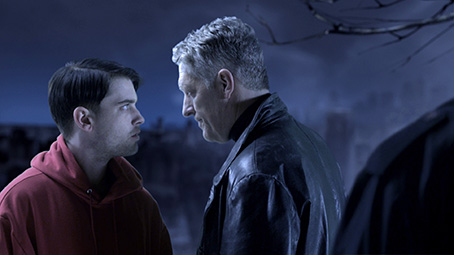
Movies were a little slower to catch on and reflect this alternative viewpoint, and Zack Snyder's big budget adaptation of Watchmen aside, it was largely down to the indies to puncture the traditional superhero bubble. My personal favourite remains James Gunn's unfussily titled 2010 Super, whose superhero wasn't a superhero at all, but an angry individual in a home-made crime-fighting costume who battled the unrighteous by beating them around the head with a metal pipe wrench.
The low-budget 2013 indie film Sparks began life as a graphic novel by Christopher Folino, one of the launch titles for the Catastrophic Comics label created by him and actor William Katt (whom horror fans will remember as the title character's prom date in Carrie). I confess to not having read it, but given that the film version was scripted and co-directed by Folio and executive produced by Katt, we can assume that this is a reasonably faithful adaptation.
It begins in 1920, and as the latest crime by the brilliantly named serial killer Ringmaster Jesus is reaching its conclusion, a meteor falls to earth close to Rochester, New York, killing scores of people and leaving thirteen survivors with radiation triggered mutations, which endows them with abilities that they genetically pass on to their children. Following a busy title sequence in which most of this is outlined, we hop forward 28 years and a bloodied and beaten fugitive named Ian Sparks (Chase Williamson) stumbles into a newspaper office and announces that he has been murdered. He has a story to tell, one that begins with the death of his parents as the result of a wayward police chase and his subsequent determination to become one of the city's unofficial and costumed crime-fighters, who are known simply as Supers.
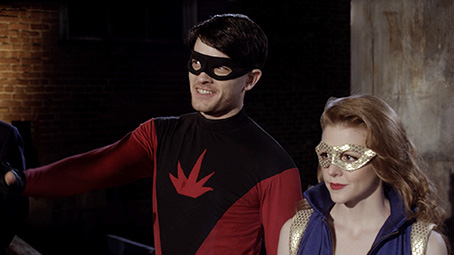
Like the protagonist of Super, there's a do-it-yourself aspect to the constructed personas of these would-be superheroes, from their self-chosen monikers to costumes that look as if they were stitched together by their mothers, or in the case of Sparks his grandmother. The unusual thing here is that most of the Supers don't actually have any particular powers, they're just good in a punch-up, and even then it depends on their level of experience and the fighting skills of their foes. On his first trip to New York, Sparks gets beaten seven ways from Sunday when he attempts to take on the city's more experienced hoodlums, and only really becomes a force to be reckoned with when he teams up with Lady Heavenly (Ashley Bell), an alluring fellow Super who becomes his crime-fighting partner and romantic other half.
In this alternate reality, becoming a Super seems to be less down to destiny than the result of ambition that's only a couple of steps sideways from the childhood dream of becoming a fireman or a train driver. This does mean that the Supers more readily fall victim to human frailties than the regular superhero. It's a lesson Sparks learns the hard way when he and Heavenly are captured by serial killer Matanza (William Katt), who soundly clobbers Sparks and violates Heavenly, after which, understandably, she's never the same. Their relationship soon crumbles and Heavenly returns to her former partner Sledge, pushing Sparks into pit a self-pitying despair. He's pulled out of it by Archer (the always lovely Clancy Brown), a cop who witnessed the death of his parents and rescued him from the vehicle in which they were killed. Archer has been keeping an eye on Sparks since his early days and helps him to develop his fighting skills, and it turns out that he is on his own crime-fighting mission, assisted by two Supers with genuine powers, the flame ball-throwing Cain (an imposing Esteban Cueto) and the shape-shifting Dawn (Marina Squerciati). It's a mission that will apparently allow Sparks to avenge the death of his parents, and so he willingly participates, but all is not what it seems.
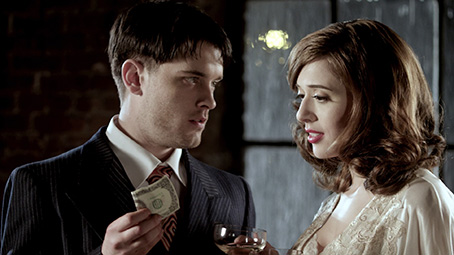
Sparks is an intriguing if somewhat oddball creation, a melding of flawed superhero story with 40s film noir and serial killer horror, an admirable ambition whose undeniable charm is sometimes undermined by the mode of its execution. It doesn't hep that some of the borrowings are so visible, with Sparks' introductory proclamation of his own death lifted from Rudolph Maté's noir classic D.O.A., the flawed superheroes having echoes of Watchmen, and Dawn's shapeshifting owing its lineage to Mystique from X-Men. And is it me or has that once popular facial morphing effect had its day in the sun? It's been a long time since we were first wowed by its use in Terminator 2, The X-Files and Michael Jackson's Black or White music video, and when it turned up here I let out a nostalgic smile and found myself wondering how long it has been since I last saw it so used.
Even by comic book adaptation standards, the film wears its stylised look on its sleeve. It's been some time since I've watched a film where so many of the CG effects look so much like CG effects. Given how realistic elements like fire and liquid can be made to look now on even a small effects budget and how solid some of the other effects are, I'm assuming their appearance here was a deliberate decision on the part of the filmmakers, presumably to make them part of a tapestry of studied artificiality that runs through the film. Intermittently the imagery has ambitions to be Sin City's younger brother or even ape the green screen fakery of Sky Captain and the World of Tomorrow, a somewhat inconsistently aesthetic that slips into post-Saw horror visuals when dealing with serial killer Matanza and his crimes. That the noir elements sometimes feel a little forced and even play as pastiche is perhaps inevitable – imaginative though he definitely is, when it comes to dialogue writing Folino is no Raymond Chandler, the younger actors look like the sons and daughters of their classical forebears, and colour-tinkered digital imagery is never going to convincingly replicate the high contrast monochrome 35mm loveliness of noir's cinematic heyday.
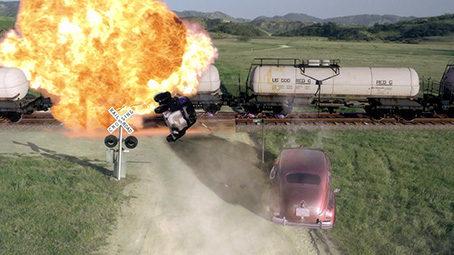
But given that Sparks was shot on a low budget in a seemingly impossible twelve days and nights (with two extra days later for pick-ups), there is still a fair amount to admire and enjoy here. The structure may be a little scruffy, but the story is moved along at a spanking pace, key story details are teasingly held back and only clarified over the course of time, and Jacob Shea's superb, full-blooded score makes the production feel a lot bigger than it actually is. Despite some shaky moments in support and a few hokey lines, the performances are solid enough, and it's nice to see Chase Williamson and Clancy Brown reunited so soon after their sterling work on Don Coscarelli's John Dies at the End. There's a superb late film coda that suggests a truly horrible downside to one particular special ability, yet of all the neat ideas that are pitched and played with here, the one that intrigued me most was the notion of a prostitute who could assume the shape of anyone she had met and touched. Frankly this sounds like the basis for an interesting film of its own.
Like so many low to medium budget films today, Sparks was shot on RED HD cameras, primarily the 4K MX with additional footage shot on the 5K RED Epic, with the edit mastered in 2K to allow for reframing and more freedom to manipulate the image. As you'd expect of an HD transfer sourced from a digital original, the picture here is crisp, spotless and free of obvious signs of (pointless) enhancement. The contrast range and colour are both excellent when the light levels permit, but much of the film takes place at night, where the noir high key lighting renders shadows as pitch black and colours are often tinkered with. All of this is deliberate, however, and the image integrity never falters. If you're looking for a reference image, the high super-wide shot of the city at 0:42:38 demonstrates just how good the picture quality is here.
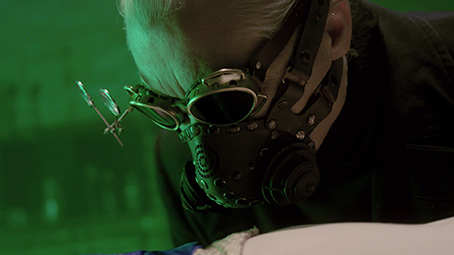
On the soundtrack front, there's a choice between linear PCM 2.0 stereo and DTS-HD Master Audio 5.1 surround. Both are well mixed with an excellent dynamic range, though the surround track benefits from its wider spread, a specific use of the surround speakers for effects and background atmospherics, and some solid LFE bass. The music sounds great on both tracks.
Commentary
Co-director and associate producer Todd Burrows, actor and executive producer William Katt, and writer, producer and co-director Christopher Folino discuss the expected aspects of the making of the film in an engaging and informative manner without getting all "I love this" about specific elements. Topics covered include the cast, the crew, the tight schedule, and the logistics of two crews shooting simultaneously (I particularly liked the story about the single 'atmosphere machine' being used by one crew that kept getting nicked by the other). I was intrigued to hear that after the shoot Folino went back and tweaked the graphic novel to reflect changes they made for the film version (purists will baulk at this, I am sure) and that at least one adult element of the original was toned down for the film version, which is a bit of a shame.
Behind the Scenes (3:40)
An old school EPK comprised of extracts from the film, footage of the shoot and snippets of an interview with executive producer/actor William Katt. Too short to be anything more than decorative when you also have a commentary on board.
Dave Hanson Outtake (0:23)
A gag take involving actor Dave Hanson, who works the names of some of the lead actors into his dialogue.
I was actually looking forward to seeing this film, and to be honest was a little disappointed with what I got on the first viewing, but a second look really helped to bring out its strengths. It's an odd mix of styles and genres, but a generally engaging one, with some of the more borrowed and even espected elements nicely undercut by inventive touches, and I include the ending in that. A fine transfer and a solid commentary make it easy to ignore the two superfluous extras. I'm not sure I'm ready to unconditionally recommend this, but it's certainly worth a look, and for some it will really click.
|